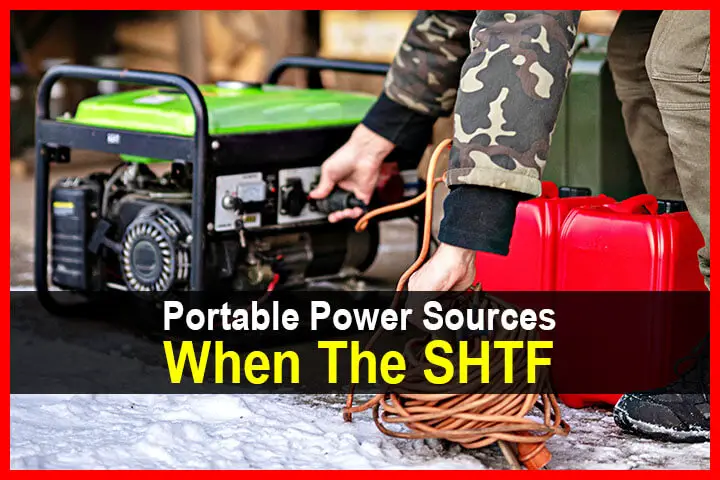Estimated reading time: 8 minutes
In emergency scenarios, reliable power sources become critical. Harnessing portable power offers an invaluable lifeline, fueling essential devices and systems when conventional electricity is inaccessible. As a prepper, choosing the right portable power options is an important decision, both for survival and maintaining a semblance of normalcy during challenging times.
This article will discuss the key types of portable power options, including solar generators and gas generators, along with other viable alternatives. These options have their unique sets of advantages and should be chosen based on the specific needs and circumstances of you and your family.
Want to save this post for later? Click Here to Pin It On Pinterest!
The Importance of Portable Power in a SHTF Situation

Having access to portable power in a SHTF situation can be a game-changer, and in some cases, a life-saver. Emergencies often bring with them power outages, affecting not only home lighting but also essential services like heating and refrigeration, making it difficult to preserve food and medication.
Imagine a scenario where a natural disaster has struck and you are stranded without electricity. The lack of power can lead to the failure of vital medical equipment, such as nebulizers or insulin pumps, which could have dire consequences for those reliant on them. Portable power options can keep these devices running, potentially saving lives in such situations.
In another scenario, consider being stranded in a remote location due to an unexpected event. The absence of electricity would mean no communication with the outside world.

However, with portable power, you could charge your mobile devices and establish contact for rescue or assistance.
Portable power can also provide essential heating or cooling when the HVAC system is down, and power lighting for safety and security. In emergency situations, these comforts can make a significant difference in maintaining morale and the will to survive. Portable power sources, therefore, are not just conveniences, but vital tools for survival in a SHTF scenario.
Battery Generators

Battery generators harness the power of Lithium Ion batteries to generate electricity, providing a sustainable and renewable source of power that’s particularly useful in emergency scenarios. The mechanism behind battery generators is straightforward. Charge up the generator with an external power source and use the built in inverter to power your gadgets.
Luckily, there are a lot of options to charge up your battery generator. This includes an AC adaptor, car charger, or even solar panels. In the case of a power outage, you’ll be relying on your vehicle’s alternator or the sun to charge up the battery.
When the power is needed, the stored energy can be converted to AC or DC power, suitable for running most electronic devices.
Among the many benefits of battery generators, the most noteworthy is their non-reliance on fossil fuels, making them environmentally friendly. They’re quiet, require little maintenance, and provide an unlimited source of power as long as the sun is shining. This makes them ideal for long-term emergency scenarios where fuel availability may be uncertain or non-existent.
However, they do have some drawbacks. Especially in a survival scenario where power is limited.
They are weather-dependent and their efficiency is directly related to the intensity of sunlight. They may not be as effective in regions with less sunlight or during winter seasons. Furthermore, they can be more expensive upfront than traditional generators.
Several high-quality battery generators are available on the market, each with its unique features and benefits.
For those who require a high power capacity, the Bluetti AC180 power station is a top contender, boasting a massive 1152Wh capacity and intelligent ingenuity. With a 500 watt solar setup you can charge one of these in 3 hours on a sunny day, perfect for those that will need it on the move.
When choosing a solar generator, it’s important to consider your power needs, available sunlight, and budget. Regardless of the model you choose, a solar generator can be an invaluable asset in a SHTF scenario.
Gas Generators

Gas generators convert chemical energy into electrical energy through fuel. This process starts when the generator’s motor burns gasoline to produce mechanical energy. This mechanical energy, in turn, drives an alternator that generates electricity. As long as there is a supply of gasoline, the generator can produce electricity.
One of the key advantages of gas generators is their high-power output and reliability. They are capable of providing a steady flow of electricity over extended periods, making them ideal for powering large appliances or entire homes during power outages. Moreover, gas generators start quickly, ensuring an almost instantaneous power supply when needed.
However, gas generators aren’t a perfect solution. They are not as environmentally friendly as their battery counterparts, as they emit carbon dioxide and other greenhouse gases.
They also rely on a steady supply of gasoline, which might not be readily available during long-term emergency situations. The unfortunate reality as well is that they can be somewhat noisy, making them much less stealthy to use.

There are several reliable gas generators on the market. Honda, for instance, is well-regarded for its quiet operation, fuel efficiency, and high-quality power output in their products. Companies like Westinghouse are another excellent choice as their products have high power capacity, remote start features, and long run time per gallon of fuel.
Other Portable Power Options

Besides gas and solar generators, there are several other portable power options available. These include portable wind turbines, and thermoelectric generators.
Portable wind turbines tap into the inexhaustible power of the wind. They’re a great renewable energy source and work particularly well in windy areas. But, their efficiency drops significantly in low-wind conditions. They are also best used in permanent structures so if you’re on the move then it might not be the best choice.

Thermoelectric generators convert heat into electricity, ideal for camping or survival scenarios where a heat source is readily available. The BioLite CampStove 2 is an example of this technology. It’s a camp stove that can cook your meals and charge your gadgets. The downside is that their power output is relatively low.
These are considered niche products and while producing results, are not as strong a candidate as the generators mentioned above.
Choosing the Right Power Source for You
Choosing the right portable power option depends on various factors. Here are some key considerations:
- Power Requirements: Determine the amount of power you need. Smaller gadgets like phones require less power than large appliances.
- Frequency of Use: If you plan to use it frequently, consider durability and maintenance needs.
- Portability: If you’re on the move, weight and size matter. Smaller devices like battery banks or generators will be much easier to manage.
- Environment: Your environment greatly influences your choice. Battery generators work best in sunny areas with solar panels, while a gas generator is better for colder climates.
- Budget: Even though money doesn’t really apply when SHTF, consider your current budget. Higher initial investments can lead to long-term savings, especially with renewable energy options.
The best case scenario would be to have multiple power options. This let’s you still be able to use power even if sunlight or fuel isn’t around to power up your existing generators.
Conclusion
Having portable power options during emergencies is crucial for our safety and wellbeing. They provide us with the ability to maintain communication, access to vital information, and keep necessary equipment running. By investing in a portable power option that aligns with your needs, you are investing in your security and peace of mind in a time when you’ll need more of it.
Like this post? Don’t Forget to Pin It On Pinterest!



















